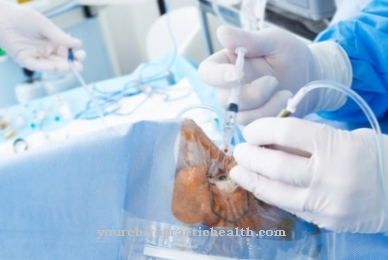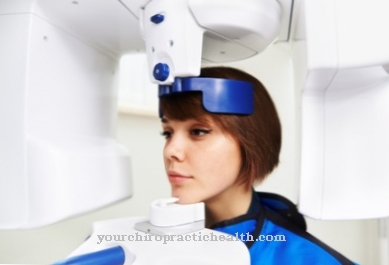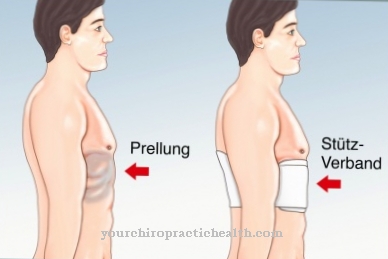The Connective tissue massage corresponds to a reflex therapy that triggers a response in the organs, in the musculoskeletal system and in the skin via the cuti-visceral reflex arc. After a tactile finding, the therapist works the connective tissue with tangential stimuli. The connective tissue massage fulfills therapeutic and diagnostic functions.
What is connective tissue massage?

Connective tissue massage is a subcutaneous reflex therapy that was launched in 1929 by the physiotherapist E. Dicke. At the time, she suffered from a disability that could have required a leg amputation.
She treated her severe back pain by stroking her sacrum and iliac crest firmly. She then felt it tingling and stinging in her sick leg, even though the extremity was actually clinically numb. From this experience, Dicke developed the massage technique. The basic assumption of the method is the observation that diseases of the internal organs cause tension differences in the connective tissue of the subcutaneous tissue. These differences in tension are felt and removed by the masseur.
Manual stimulation therapy works with tangential tensile stimuli. In this procedure, the skin technique meets the subcutaneous technique and the fascia technique. The treated zones trigger a reflex reaction of the organs, the musculoskeletal system and the skin via the cuti-visceral reflex arc. The best-known sub-form of connective tissue massage is segment massage. Connective tissue massage fulfills both diagnostic and therapeutic purposes clinically.
Function, effect & goals
The basis of every connective tissue massage is a tactile finding in the tissue. The therapist must assess the fluid content of the tissue, identify any rheumatoid nodules in the subcutaneous tissue and identify any differences in tension in the muscles.
The tactile findings can be, for example, subcutaneous turgor changes, adhesions, sensory disorders or scar disorders. After the diagnosis, the therapist stimulates the affected areas with a special massage technique that is intended to balance the tension. The connective tissue massage not only affects the local tissue, but also reaches remote areas such as organs and organ functions. As a rule, the massage is performed twice or three times a week.
Each session lasts around ten to 15 minutes. Various complaints respond particularly well to the massage technique. The most important indications for connective tissue massage include inflammation-related gastrointestinal disorders and inflammation-related liver or biliary problems. Other types of pain should also be positively influenced by the massage, such as migraines or menstrual cramps. In rheumatic diseases, the massage technique relieves joint pain. In the field of cardiovascular diseases and vascular diseases, the connective tissue massage can have a positive effect on non-inflammatory venous disorders such as varicose veins in addition to circulatory disorders in the legs.
The connective tissue massage thus has a therapeutic influence on vegetative regulatory mechanisms and creates a normal tone in the connective tissue, in the internal organs, in the muscles and in the nerves or vessels via the cuti-visceral and cuti-cutaneous reflex arc. The first reaction to the massage corresponds to hyperemia, which is the first reaction. In the course of the treatment, the tissue elasticity normalizes. The vasomotor system, secretion and motility return to normal. The connective tissue zones as starting points for the massage correspond mainly to the Head zones. They are divided into head zones, bronchial zones, arm zones, stomach zones and liver zones.
In addition, there are heart zones, kidney zones, intestinal zones, genital zones and bladder zones or venous lymph zones. As a rule, the actual massage begins with working on the pelvic region. Later, the work steps are devoted to the whole back and finally also include the stomach. Various techniques can be used for processing. With the two-dimensional techniques, the therapist shifts the subcutaneous tissue with the thumb and fingertips. In the skin technique, it superficially shifts the tissue in the shifting layer of the skin. The subcutaneous technique calls for a stronger pull. The fascia technique has the strongest pull of all techniques and corresponds to processing the fascia edges with the fingertips.
Risks, side effects & dangers
With an experienced therapist, connective tissue massage does not actually involve any risks or dangers. However, patients find the procedure painful. A bright and clear feeling of cutting begins in the treated tissue area.
The higher the tension in the tissue, the stronger the feeling of being cut. Wheals sometimes form temporarily on the skin. Not everyone should take part in a connective tissue massage without hesitation. Contraindications to the technology are acute inflammation, acute asthma attacks or heart diseases and tumors. Acute fever, injuries or myositis and thrombosis are also considered contraindications. For all vascular diseases, the massage should only be done in consultation with the attending physician.
The same applies to acute inflammation, infectious diseases, a tendency to bleed or circulatory problems. The massage method has now proven to be particularly productive for diseases of the musculoskeletal system. Spinal column syndromes, rheumatic diseases, arthroses and trauma are therefore considered indications for a connective tissue massage. Some diseases of the internal organs are also typical indications. These include, for example, respiratory diseases or diseases in the urogenital area.
Vascular diseases such as functional arterial circulatory disorder, arteriosclerosis or post-thrombotic syndrome are also possible indications. The treatment has already been just as successful for neurological disorders such as paresis, neuralgia or spasticity. In case of doubt, a doctor should always be consulted in order to assess possible risks and rule out undesirable side effects. In the meantime, the massage technique has been further developed and has thus become part of the subcutaneous reflex therapy according to Häfelin.



























